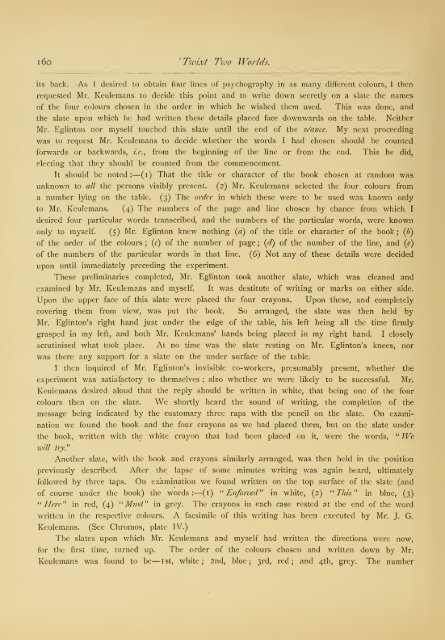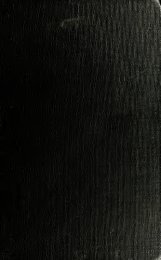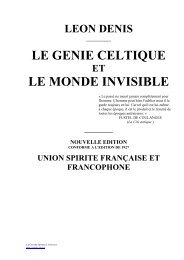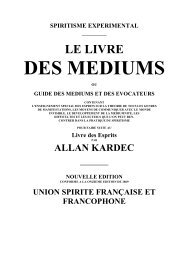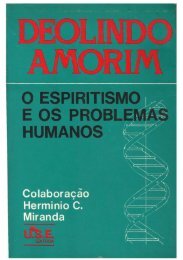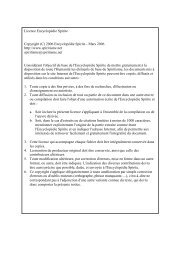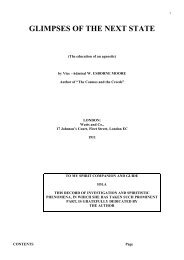'Twixt two worlds : a narrative of the life and work of William Eglinton
'Twixt two worlds : a narrative of the life and work of William Eglinton
'Twixt two worlds : a narrative of the life and work of William Eglinton
Create successful ePaper yourself
Turn your PDF publications into a flip-book with our unique Google optimized e-Paper software.
<strong>the</strong><br />
1 60<br />
'<br />
Twixt Two Worlds.<br />
its back. As I desired to obtain four lines <strong>of</strong> psychography in as many different colours, I <strong>the</strong>n<br />
requested Mr. Keulemans to decide this point <strong>and</strong> to write down secretly on a slate <strong>the</strong> names<br />
<strong>of</strong> <strong>the</strong> four colours chosen in <strong>the</strong> order in which he wished <strong>the</strong>m used. This was done, <strong>and</strong><br />
<strong>the</strong> slate upon which he had written <strong>the</strong>se details placed face downwards on <strong>the</strong> table. Nei<strong>the</strong>r<br />
Mr. <strong>Eglinton</strong> nor myself touched this slate until <strong>the</strong> end <strong>of</strong> <strong>the</strong> seance. My next proceeding<br />
was to request Mr. Keulemans to decide whe<strong>the</strong>r <strong>the</strong> words I had chosen should be counted<br />
forwards or backwards, i.e., from <strong>the</strong> beginning <strong>of</strong> <strong>the</strong> line or from <strong>the</strong> end. This he did,<br />
electing that <strong>the</strong>y should be counted from <strong>the</strong> commencement.<br />
It should be noted :— (1) That <strong>the</strong> title or character <strong>of</strong> <strong>the</strong> book chosen at r<strong>and</strong>om was<br />
unknown to all <strong>the</strong> persons visibly present. (2) Mr. Keulemans selected <strong>the</strong> four colours from<br />
a number lying on <strong>the</strong> table. (3) The order in which <strong>the</strong>se were to be used was known only<br />
to Mr. Keulemans. (4) The numbers <strong>of</strong> <strong>the</strong> page <strong>and</strong> line chosen by chance from which I<br />
desired four particular words transcribed, <strong>and</strong> <strong>the</strong> numbers <strong>of</strong> <strong>the</strong> particular words, were known<br />
only to myself. (5) Mr. <strong>Eglinton</strong> knew nothing (a) <strong>of</strong> <strong>the</strong> title or character <strong>of</strong> <strong>the</strong> book ; (6)<br />
<strong>of</strong> <strong>the</strong> order <strong>of</strong> <strong>the</strong> colours ;<br />
(c) <strong>of</strong> <strong>the</strong> number <strong>of</strong> page ; (d) <strong>of</strong> <strong>the</strong> number <strong>of</strong> <strong>the</strong> line, <strong>and</strong> (e)<br />
<strong>of</strong> <strong>the</strong> numbers <strong>of</strong> <strong>the</strong> particular words in that line. (6) Not any <strong>of</strong> <strong>the</strong>se details were decided<br />
upon until immediately preceding <strong>the</strong> experiment.<br />
These preliminaries completed, Mr. <strong>Eglinton</strong> took ano<strong>the</strong>r slate, which was cleaned <strong>and</strong><br />
examined by Mr. Keulemans <strong>and</strong> myself. It was destitute <strong>of</strong> writing or marks on ei<strong>the</strong>r side.<br />
Upon <strong>the</strong> upper face <strong>of</strong> this slate were placed <strong>the</strong> four crayons. Upon <strong>the</strong>se, <strong>and</strong> completely<br />
covering <strong>the</strong>rn from view, was put <strong>the</strong> book. So arranged, <strong>the</strong> slate was <strong>the</strong>n held by<br />
Mr. <strong>Eglinton</strong>'s right h<strong>and</strong> just under <strong>the</strong> edge <strong>of</strong> <strong>the</strong> table, his left being all <strong>the</strong> time firmly<br />
grasped in my left, <strong>and</strong> both Mr. Keulemans' h<strong>and</strong>s being placed in my right h<strong>and</strong>. I closely<br />
scrutinised what took place. At no time was <strong>the</strong> slate resting on Mr. <strong>Eglinton</strong>'s knees, nor<br />
was <strong>the</strong>re any support for a slate on <strong>the</strong> under surface <strong>of</strong> <strong>the</strong> table.<br />
I <strong>the</strong>n inquired <strong>of</strong> Mr. <strong>Eglinton</strong>'s invisible co-<strong>work</strong>ers, presumably present, whe<strong>the</strong>r <strong>the</strong><br />
experiment was satisfactory to <strong>the</strong>mselves ;<br />
also whe<strong>the</strong>r we were likely to be successful. Mr.<br />
Keulemans desired aloud that <strong>the</strong> reply should be written in white, that being one <strong>of</strong> <strong>the</strong> four<br />
colours <strong>the</strong>n on <strong>the</strong> slate. We shortly heard <strong>the</strong> sound <strong>of</strong> writing, <strong>the</strong> completion <strong>of</strong> <strong>the</strong><br />
message being indicated by <strong>the</strong> customary three raps with <strong>the</strong> pencil on <strong>the</strong> slate. On examination<br />
we found <strong>the</strong> book- <strong>and</strong> <strong>the</strong> four crayons as we had placed <strong>the</strong>m, but on <strong>the</strong> slate under<br />
<strong>the</strong> book, written with <strong>the</strong> white crayon that had been placed on it, were <strong>the</strong> words, " Wc<br />
will try."<br />
Ano<strong>the</strong>r slate, with <strong>the</strong> book <strong>and</strong> crayons similarly arranged, was <strong>the</strong>n held in <strong>the</strong> position<br />
previously described. After .<br />
lapse <strong>of</strong> some minutes writing was again heard, ultimately<br />
followed by three taps. On examination we found written on <strong>the</strong> top surface <strong>of</strong> <strong>the</strong> slate (<strong>and</strong><br />
<strong>of</strong> course under <strong>the</strong> book) <strong>the</strong> words: — (1) "Enforced" in white, (2) "This" in blue, (3)<br />
"Here" in red, (4) "Must" in grey. The crayons in each case rested at <strong>the</strong> end <strong>of</strong> <strong>the</strong> word<br />
written in <strong>the</strong> respective colours. A facsimile <strong>of</strong> this writing has been executed by Mr. J. G.<br />
Keulemans. (See Chromos, plate IV.)<br />
The slates upon which Mr. Keulemans <strong>and</strong> myself had written <strong>the</strong> directions were now,<br />
for <strong>the</strong> first time, turned up. The order <strong>of</strong> <strong>the</strong> colours chosen <strong>and</strong> written down by Mr.<br />
Keulemans was found to be— 1st, white; 2nd, blue; 3rd, red; <strong>and</strong> 4th, grey. The number


